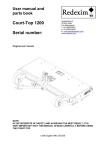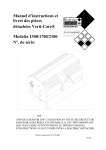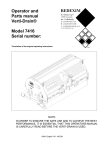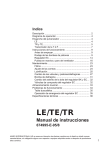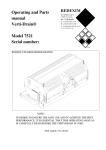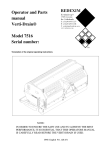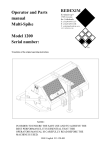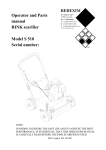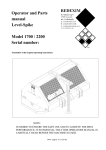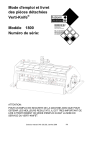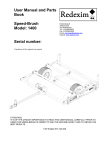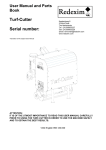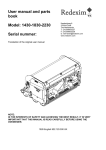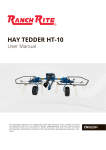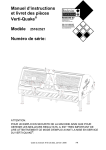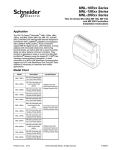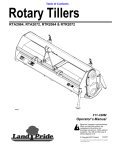Download Operator and Parts manual Verti-Core® Models 1300
Transcript
Operator and Parts manual Verti-Core® Redexim Models 1300/1700/2100 Serial number: NOTE: IN ORDER TO ENSURE THE SAFE USE AND TO ACHIEVE THE BEST PERFORMANCE, IT IS ESSENTIAL THAT THIS OPERATORS MANUAL IS CAREFULLY READ BEFORE THE VERTI-CORE IS USED. Product manual code 914.120.400 FOREWORD. Congratulations on the purchase of your VERTI-CORE. To ensure the safe and lasting operations of this VERTI-CORE you (and anyone using the machine) should read and understand this user’s manual. A complete knowledge of the contents of the manual is necessary in order to ensure the safe use of this machine. The VERTI-CORE is not an independently operating machine. It is the responsibility of the user to use the correct tractor. The user will also need to check the tractor / VERTI-CORE combination on safety aspects, noise level, user instructions and risk analysis. The VERTI-CORE is intended exclusively for grass fields or areas on which grass can grow. On the following page, we will begin with the safety instructions. Every user must be familiar with these instructions and must follow them carefully. Below you will find a registration card, which should be returned to us so that we are able to process any future claims. In this manual, many instructions are given which are stated in a number sequence. The user must follow the instructions according to this sequence. If the * appears this refers to safety instructions. If the @ is used, this refers to a tip and/ or note. GUARANTEE CONDITIONS. THIS VERTI-CORE PRODUCT IS DELIVERED TO THE CUSTOMER ACCOMMPANIED BY A GUARANTEE AGAINST DEFECTS IN THE MATERIALS USED. THIS GUARANTEE APPLIES FOR A PERIOD OF 12 MONTHS AS OF THE DATE OF PURCHASE. VERTI-CORE GUARANTEES ARE SUBJECTED TO THE "GENERAL CONDITIONS FOR SUPPLY OF PLANT AND MACHINERY FOR EXPORT, NUMBER 188", WHICH ARE PUBLISHED UNDER THE AUSPICES OF THE UNITED NATIONS ECONOMIC COMMISSION FOR EUROPE. REGISTRATION CARD. For your own record, copy the information from the registration card to the table hereunder Serial number of machine Name of your distributor Date of purchase Any remarks 2 SAFETY INSTRUCTIONS. 1. Always use the VERTI-CORE with the correct tractor as described in the technical information 2. The user is responsible for a safe Tractor/VERTI-CORE combination. The combination must be tested for noise, safety, risk and easy usage. It is also necessary to draw up user instructions. 3. The VERTI-CORE is suited exclusively to grass fields. 4. Every VERTI-CORE user must be fully informed of the information contained in the user manual. 5. Inspect the ground where the VERTI-CORE is to be applied. Remove loose obstacles, avoid uneven ground. 6. Never step off the tractor if the engine is still running. 7. Ensure that other people are standing at least 4 mtr. (14' ) away from the VERTI-CORE. 8. Use appropriate clothing. Wear strong shoes with a steel inforced toe cap, long trousers, tie up long hair. Do not have any loose pieces of clothing. 9. Never try to force the VERTI-CORE, a situation which is visible in the partial loosening of the front roller from the ground and unstable behavior of the VERTICORE. 10. Check the VERTI-CORE once a week to ensure there are no loose screws or nuts and bolts. 11. The VERTI-CORE may never be used without protection covers and safety stickers. 12. NEVER crawl underneath the VERTI-CORE. If you need to work underneath, turn the VERTI-CORE on its front. 13. Always switch off the engine and uncouple the power take off, before starting any maintenance, adjustment or repair. Also block the VERTI-CORE against sinking and block it against forward/backward movement or sliding. 14. Use only the original VERTI-CORE spare parts/ tines in order to ensure the safe operation of the machine. 15. Never use the VERTI-CORE in the dark, in heavy rain, on frozen ground, stormy conditions or on slopes greater than 20 degrees. 16. Before operating the machine, also read the instructions and the maintenance information for the power take off. This component has its own certification mark. 17. Maintain a log book of repairs. 18. If any modifications are carried out on the machine the CE certification mark will be no longer valid. The User/Dealer himself must then have the machine recertified. 3 CONTENTS. Paragraphe Description Page Foreword 2 Guarantee conditions 2 Registration card 2 Safety instruction 3 1.0 Technical specification 5 2.0 First setup, lifting machine from pallet 6 3.0 General controls 7 4.0 PTO 8 4.1 PTO length 8 4.2 Use of PTO 9 4.3 Slip clutch information and maintenance 9 5.0 Working depth adjustment 10 6.0 Groundspeed 10 7.0 Starting procedures 11 8.0 General usage of Verti-Drain 11 8.1 Some practical user notes 12 8.2 Transport of Verti-Drain 12 9.0 Uncoupling of the Verti-Drain 12 10.0 Problem analysis 13 11.0 Maintenance 14 12.0 EU-Declaration 14 13.0 Technical information 15 13.1 Torque settings 16 13.2 The crankshaft 16 13.2.1 Replacing the transmission oil seal 17 13.2.2 Replacing of a crank and crank bearing 17 13.2.3 Removing the crankshaft tension 18 Options, tines 18 14.0.1 Solid tines 19 14.0.2 Hollow tines 19 14.1 Options, Multi tine heads 19 14.2 Options, Windrow kit 20 14.3 Options, Turf hold down kit 21 14.0 4 1.0 TECHNICAL SPECIFICATIONS Model 1300 1700 2100 Overall dimension (LxWxH) Working width 885x 1450x 700 mm (35 x 58 x 28”) 1.30 mtr ( 52”) 885x 1855x 700 (35 x 74 x 28”) 1.70 mtr (68”) 885x 2265x 700 (35 x 91 x 28”) 2.10 mtr ( 84”) Working depth Up to 125 mm (5”) Up to 125 mm (5”) Up to 125 mm (5”) 1.7 km/h (1.1 mph) 1.7 km/h (1.1 mph) 3.3 km/h (2.2 mph) 3.3 km/h (2.2 mph) Up to 540 rpm Up to 540 rpm Tractor speed @540 rev’s at PTO Hole spacing 52 mm (2- 1.7 km/h (1.1 mph) 1/16”) 3.3 km/h (2.2 mph) Hole spacing 100 mm (4”) PTO speed Up to 540 rpm Weight 480 Kg (1050 lbs) 550 Kg (1210 lbs) 625 Kg (1375 lbs) Hole spacing side-to-side 52 mm (2-1/16”) 52 mm (2-1/16”) 52 mm (2-1/16”) Hole spacing in drive direction Recommended minimum tractor size 25- 100 mm (1- 4”) 25- 100 mm (1- 4”) 25- 100 mm (1- 4”) 22 Hp with minimum lift capacity of 650 kg (1450 lbs) 28 Hp with minimum 35 Hp with minimum lift capacity of 750 kg lift capacity of 850 kg (1670 lbs) (1890 lbs) Capacity : Spacing 52 mm (2-1/16”) Up to 2061 m³/hour (22181 sq ft/hour) Up to 3964 m³/hour Spacing 100 mm (4”) (42655 sq ft/hour) Shipping dimensions 700 x 1450 x 900 mm (L x W x H) (28 x 58 x 36 “) Three point linkage 3-point Cat 1 Up to 2696 m³/hour (29006 sq ft/hour) Up to 5184 m³/hour (55780 sq ft/hour) 700 x 1860 x 900 (28 x 74 x 36 “) 3-point Cat 1 Transmission grease Life time grease EP00 Life time grease EP00 Life time grease EP00 Lubrication grease EP 2 EP 2 Slip clutch setting (Max) 400 Nm (3540 lb.inch) 400 Nm (3540 lb.inch) 400 Nm (3540 lb.inch) Standard items Set hollow tines 13/16 x 6 top & side eject PTO Turf hold down kit Turf hold down fingers multi tine head Multi tine heads Windrow kit Set hollow tines 13/16 x 6 top & side eject PTO Turf hold down kit Turf hold down fingers multi tine head Multi tine heads Windrow kit Options Up to 3330 m³/hour (35830 sq ft/hour) Up to 6404 m³/hour (68905 sq ft/hour) 700 x 2280 x 900 ( 28 x 92 x 36”) 3-point Cat 1 EP 2 Set hollow tines 13/16 x 6 top & side eject PTO Turf hold down kit Turf hold down fingers multi tine head Multi tine heads Windrow kit Fig.1. 2.0 FIRST SETUP, LIFTING MACHINE FROM PALLET. The machine stands vertically up on the pallet. To remove the pallet and get the machine horizontal on the ground, handle as follows (see fig.1 ): 1. Open the rear cover 2. Connect a cable to main chassis * ensure the cable/crane/lift truck can lift minimum 1000 Kg.(2200 lbs). 3. Raise machine with pallet 50 mm (2")from the ground. 4. Remove pallet by sliding it over the bottom 3-point pins * Do not crawl under the machine 5. Lower the machine gentle till 3-point connecting plates contact the ground. 6. Drop the machine further, enabling it to rotate on its front roller. 7. Gently lower the machine till it stands on the front roller and rear support jack. 8. Connect the machine to a tractor. * Use correct tractor see specifications. 9. Lower the machine on the ground and adjust the angle of 90 degrees with top link @ this angle is very important, see further. 10. Adjust tractor lower link stabilizers to limit sideways movement till about 100 mm (4”). 12. Assemble the tines. Use some grease on the shank. 13. PTO length, see 3.1 6 Fig.2. 3.0 GENERAL CONTROLS In fig.2. some key details of the machine are shown, as follows: 1. PTO input shaft. Slip clutch should be assembled at this shaft. 2. PTO protection covers at the machine. Top one can be removed for maintenance. 3. Lower 3-point linkage pins. May be repositioned and facing in or out. 4. Safety decal RA, before using machine read manual. Decal is located at the toolbox with manual. 5. Front roller support lock bolts. 6. Protection shield. Should always be on. 7. Working depth indicator. Note the indication is related to maximum tine length. 8. Spindle to adjust working depth. 9. Safety decal, Keep 4 mtr (14') distance to the machine .Turn engine off when maintaining or repairing machine and watch moving parts/ tight spaces, squeezing your fingers etc. * All decal should be on the machine and understood all the time 10. Serial number of machine can be found inside 11. Knurled nuts for securing the rear access door of the VERTI-CORE. * rear access door should always be closed and free of any damage. 12. Rear support jack. 13. Secure pin for rear support jack. 14. R pin to lock secure pin 13. 7 Lstandard= 34mm (1.339") L minimum= 32.5mm (1.280") Fig.3. 4.0 PTO. The PTO is a very important item. It drives the machine from the tractor and ensures the safe operation when correctly maintained and installed. The PTO shaft has its own CE certification. Read the PTO shaft manual, which is connected to the shaft itself. 4.1 PTO LENGTH. The length of the PTO is very important. When too long, the transmission of the tractor and/or VERTI-CORE may be damaged. When the overlap length of the tubes drops under 150 mm (6") anytime, the PTO may get damaged. * the length changes when the machine is raised or when another tractor is used. To cut the standard PTO from new or for another tractor, work as follows (see fig. 3): 1. Measure the distance A between tractor PTO shaft and VERTI-CORE PTO shaft from groove to groove when machine is on the ground at correct angle and attached to the tractor. 2. Measure the length B of the PTO in its shortest position from lock pin to lock bolt. 3. Split PTO in two pieces and remove safety cover from each end 4. Both tubes and safety cover ends should be shortened: (B - A) + 75 mm (3"). 5. Deburr all items, use some grease and put all parts together. 6. Assemble the slip clutch side of the PTO to the VERTI-CORE gearbox. @ Torque for lock bolt should be 80 Nm (700 lb.in.)and checked every 40 hours 7. Connect other side to the tractor. 8. Check overlap of tubes. * Never run machine with a damaged PTO safety cover. Replace it first. 8 4.2 USE OF PTO For the correct use of the PTO, the following items need to be checked: 1. During work the angle of the joints may never exceed 30 degrees 2. The joints have to be in line all the time 3. The tube overlap should always be minimal 150 (6") mm 4. Never use the machine with a damaged PTO protection cover. 5. For greasing see par. 11.0 Maintenance. 4.3 SLIPCLUTCH INFORMATION AND MAINTENANCE. The slip clutch will protect your machine against breakages when correctly used and maintained. The following items are important. 1. The spring length is standard set at 34.0 mm , 1.339". 2. When the slip clutch slips, the bolt/nuts may be tightened a quarter of a turn at a time, till the minimum length of 32.5mm, 1.280" on the spring is reached. Any further compression will overload the machine. @ If too tight the machine may break down in the end or unsafe situations may occur. 3. The slip clutch should be maintained every month. Work as follows; - Remove the top PTO protection cover of the machine - Loosen up all bolts/ nuts two turns. - Run the machine in the field at very low rpm's - If the clutch slips, stop after 10 seconds. - If it doesn't slip, loosen bolts more or go to (annual) maintenance. - When the slip clutch has slipped, tighten the bolts/nuts up to the point the slip clutch works fine. * Do not tighten it to the previous setting right away. 4. Annual maintenance: - remove PTO from machine. - inspect PTO shaft parts. Damaged parts should be replaced. - disassemble the slip clutch by removing all bolts/nuts that hold the springs - the slip clutch should fall apart in pieces. - lay down the pieces and inspect parts. If parts are damaged or worn, replace them. - clean all mating surfaces. - assemble all parts and tighten bolts/nuts till the springs are all set at 34.0 mm , 1.339". - Grease both tubes and assemble both PTO parts to each other. - Assemble the PTO and mount it to the machine. - Readjust the springs of the slip clutch when necessary as previously described. @ The slip clutch protects the machine only against peak loads, when correctly adjusted. A continuous overload will damage the machine in the long run and is not protected by the slip clutch. Do not overload your machine. 9 5.0 WORKING DEPTH ADJUSTMENT. The working depth can be adjusted when the machine is lifted from the ground as follows, see fig. 2: Unscrew bolts 5 at each side of the machine one turn. Screw spindle 8 in or out. Every revolution is 4 mm (0.160"). The decal 7 at each side of the machine shows the actual depth. When the correct depth is reached, tighten the bolts 5 at each side. @ Never adjust one side more than 4 turns. Compensate the other side first before proceeding. @ The value at the decals is only true when 125 mm (5") long tine are used. When shorter tines are used, deduct the length difference to the 125 mm (5") from the actual decal reading. @ Clean and spray the spindle and nut with anti-sticking grease oil every 100 hours, to prevent dirt sticking on the nut. 6.0 GROUNDSPEED. The groundspeed determines the hole spacing D in the drive direction. The input speed B, Fig.4. on the PTO may be maximum 540 rpm. When stones or rocks are expected, the input speed should be reduced. With heavier tines or attachments, the tine holders may start to vibrate, causing an irregular hole spacing.. Lower rpm's at that time. @ If the machine is not set correctly behind the tractor, see fig.1., different angles at the PTO may cause vibration in the drive line of the VERTI-CORE. This vibration can hurt the machine and also the performance of the holes in the ground. @ If the PTO shaft is incorrectly fitted (too long or too short), extra forces are applied to the input shaft of the gearbox. Damage may occur. B C A Fig.4. 10 7.0 STARTING PROCEDURES. The starting procedure is VERY important. If the start up is not done as described hereunder, serious damage to the machine may occur. Proceed as follows, see fig.4.: 1. Drive to the spot you want to start the operation. 2. Lower the machine, till the lowest tines are almost on the ground. 3. Set tractor engine at app. 1200 rpm's 4. Put tractor in correct gear, and start moving forward (A) 5. Engage PTO at tractor (B) 6. DURING rolling forwards with the machine RUNNING, GENTLY lower the machine in the ground (C), till front roller is tight on the ground. 7. Increase engine rpm's till the maximum value advised. At the end of a pass, quit the operation as follows: 1. Lower engine rpm's till about 1200. 2. Raise machine out of the ground. 3. As soon as all tines are out of the ground, disengage PTO. 4. Raise machine further, till the lowest tines are at least 120 mm (5") above the ground. 5. Move to the next spot and start again as described above. @ It is absolutely necessary to proceed as described above. If the machine is put into the ground first, without the PTO running, serious damage may occur. @ The machine needs to be lowered GENTLY. @ Be careful with driving backwards. During work the front roller needs to be stable on the ground. If the machine starts to be unstable, change the rpm's on the PTO. If this doesn't make any difference, adjust the working depth or change to other tines who penetrate easier. @ If nothing is done on the instability of the machine, serious troubles may arise afterwards. The machine is NOT protected against these circumstances on the long term. @ Never drive backwards with the tines in or close to the ground. @ NEVER drive backwards, when the lowest tines are less than 120 mm (5") above the ground. If the tines get caught, serious damage will appear on the machine. @ Do not use a hydraulic top link. 8.0 GENERAL USAGE OF THE VERTI-CORE. The VERTI-CORE can only be used when the circumstances are right. Check the following items: 1. Are there any loose objects on the field. If so, these must be removed first. 2. Are there any slopes. The maximum slope for the VERTI-CORE is 20 degrees. Always operate the VERTI-CORE from the top to the bottom of a slop. 3. Are there any pipes/wires/cables in the ground. If so, ascertain at what depth and set the working depth at a maximum of 60% of the pipe etc. depth. 4. Are there any hard objects in the ground. If so, operate the VERTI-CORE with a very low PTO speed, or adjust working depth. 5. Is there any danger of flying objects such as golf balls, which could distract the attention of the driver ? If so, the VERTI-CORE can not be operated at that moment. 6. Is there any danger of subsidence or land/mud slides ? If so, the VERTI-CORE cannot be operated on the field at that moment. 7. Is the ground frozen or very wet. Postpone operation till circumstances are better. 8. When ground is very compacted, use shorter thinner tines to penetrate, or adjust working depth. 11 8.1 SOME PRACTICAL USER NOTES. Since the circumstances can differ so much, we want to inform you about some practical notes: 1. If the (weak) roots can’t hold the grass in place, use the Turf hold down fingers, change to another tine size, reduce working depth and/ or increase hole spacing. 2. If the hole spacing in drive direction is not regular, increase or decrease the PTO rev’s, since the tine may have entered into their own “frequency” range. 3. If the holes aren’t straight enough or the hole edge isn’t satisfactory, the machine may be tipped forward or backward via the top link for any improvement. Do not over adjust this. The angle may vary between 80 and 100 degrees, see Fig. 1. 4. When the hollow tines do not produce a core, clean them carefully and/ or use another size. Changing working depth or irrigation may help as well. 8.2 TRANSPORT OF VERTI-CORE ALONG PUBLIC ROADS. The user is responsible for the transport of the VERTI-CORE behind the tractor along the public streets. Check on the national legislations. Across open ground a maximum speed of 12 km/h (8 mph) applies. In view of the weight of the VERTI-CORE, a higher speed could be dangerous for the driver and bystanders. The machine could also suffer damage due to jolt which can occur with higher speeds. * At least 20% of the tractor weight should rest on the front axle when machine is lifted. 9.0 UNCOUPLING OF THE VERTI-CORE. The machine can be disconnected from the tractor as follows: 1. Open the rear cover. 2. Drop the rear support jack fully down and lock it with the secure pin 3. Drop the front roller fully down, see chapter 5.0. for guidance. Or use a firm stand underneath the roller with a height of 125 mm (5”). 4. Lower the machine on a firm surface 5. Secure the front roller against rolling away. 6. Remove the top link. 7. Disconnect the PTO shaft from the tractor side 8. Disconnect the lower three point linkage arms. * Shut down the tractor engine during walking around the VERTI-CORE. 12 10.0 PROBLEM ANALYSIS. Machine vibrates Crankshaft rotates irregular Machine not at 90 degrees PTO joint angles different PTO joints not in line Tough circumstances Adjust working depth Use thinner/ shorter tines If dry, irrigate first Solid/ hollow tines Wrong tine Change tine, use shorter one Adjust working depth Are bending/ breaking Tough circumstances Use thinner/ shorter tines If dry, irrigate first Quick wearing Front roller is not stable Use solids first to break the soil Wrong tines, too much resistance Change tine size on the ground Adjust working depth Tough circumstances Use other size tines Adjust working depth Irrigate first Don’t do job in one pass PTO breakages Slip clutches slips often Check setting Replace lining plates Clean clutch internally Tubes are cracking PTO angles too wide PTO angles not the same Damage to the turf Oval holes Soil too wet Change tine angle setting by top link Reduce forward speed Turf damage Adjust working depth Use thinner tines Change hole spacing Crankshaft problems Big end nuts slacken Solve vibration, see vibration Crankshaft bearing collapsed Incorrectly assembled after repair. Remove, clean, use loctite 13 11.0 MAINTENANCE. Pre-Delivery-Inspection Check bolts/ nuts Connect the unit to a tractor Run unit for 5 min See instructions in this manual Look and listen After first 20 hours (new or repaired) Grease PTO and roller 2 shots each EP 2 Check bolts/nuts Inspect machine closely After every 100 hours 4 shots each EP 2 Grease PTO and rollers Check bolts/ nuts Inspect machine closely Grease spindles front roller 12.0 EU-Declaration . We, Redexim Utrechtseweg 127 3702 AC Zeist Holland, hereby declare fully on our authority that the product: VERTI-CORE 1300/ 1700/ 2100, WITH MACHINE NUMBER AS INDICATED ON THE MACHINE AND IN THIS MANUAL, to which this declaration applies, has been manufactured in line with NEN-EN 292-1, NEN 292-2 and NEN-EN 294, according to the stipulations of: The Machine Directive 89/392, updated by 93/368/EEG, 93/44/EEG and 93/68/EEG Redexim Holland Jan 2002. 14 13.0 TECHNICAL INFORMATION. Generally speaking, the VERTI-CORE is not a complicated machine. A couple of technical items will be explained. If you still have questions, please contact your dealer, who is willing to assist you. Fig.5. Fig.6. 15 Fig.7. In the above fig.5, 6 and 7. the torque setting for the several bolts/nuts is given and the timing of the crankshaft. Refer to the figure that represented your model. Use the self lock nuts only once. The machine has three different kind of cranks: one or sometimes two for the gearbox, one for the big end pin head and one for the big end pin nut. Refer to the part pages for more information Carefully time the crankshaft after parts are replaced. Damages/ vibrations may occur when not properly done. Use only genuine parts. • Be carefull with moving/ rotating parts inside. They may crunch your fingers , hands and arms. • Place the machine on firm studs, before starting any repair. 13.1 TORQUE SETTINGS. In fig.5, 6 and 7., the torque settings of the most important bolts/nuts are given. For the ones the torque setting is not mentioned, please be sure that they are tightened as a similar size bolt/nut would be tightened. If bolts/nuts are working themselves loose, loctite may be applied. 13.2 THE CRANKSHAFT. In fig.8. the assembly of the crankshaft is given. Also look at the spare part page for a more clear view and setup. 16 Gearbox Fig.8. 13.2.1 REPLACING THE TRANSMISSION OIL SEAL. In fig.8. a top view of the crankshaft is given. To replace a main oil seal at the transmission, handle as follows: 1. Loosen nuts II and IV, which may be tight through the loctite. Some heat may help. 2. Remove nuts III, remove crank handles VI. 3. Remove big end IX. 4. Slacken nut VIII, remove handle X. 5. Pull oil seal out, clean area, insert new seal.. 6. Assemble (new) handle X, watch the timing. 7. Fill outside area between handle X and profiled shaft with silicon paste. 8. Attach new locking plate and nut VIII. 9. Tighten and lock the nut according specifications (fig.5,6 and 7). 10. Assemble all other parts the way they were removed. 11. If the crankshaft seems lumpish, continue “removing crankshaft tension”, 15.2.3 13.2.2. REPLACEMENT OF A CRANK WITH BEARING. Replacing a crank is necessary when it is cracked or when the big end nuts start to come loose on a regular base. Either the crank bearing, the crank bearing fitting or the big end pin holes in the crank are damaged. Replace the crank / bearing as soon as possible, to avoid any more damage to other parts, as follows: 1. Remove the big end V. 2. Remove the handles IV. 17 3. Take the profiled shaft with bearing out. 4. Remove bearing from profiled shaft. 5. Replace the parts and assemble the other way round. @ Use loctite for nut II, III and VIII. 13.2.3 REMOVING THE CRANKSHAFT TENSION. If parts have been replaced on the crankshaft, the crankshaft may seem running tight. This is because of possible tension in the crankshaft parts. It is necessary to remove these, as follows ,see fig.8.: 1. Tap the center of the crank adjacent to the gearbox, alternately left and right. 2. Feel whether the crank moves and continue till the crank has nested. 3. Repeat this operation with the adjacent crank and continue this way till the crankshaft will operate more smoothly. @ After any repair on the crankshaft, the crankshaft nuts should be checked regularly, after first 10 hours. @ Don’t assemble the cranks at the wrong side of the machine. See the spare part for the right part numbers. 14.0 OPTIONS, TINES Tines are essential for the correct working of the machine. Several tines are available for this machine, see the spare part pages for a total overview. Generally speaking, tines can be divided into two categories: Solids and Hollows. We advise using genuine tines, since they are fully adapted to the machine. In fig.9,10 and 11. several tine combination are given. The standard tine holders have 4 x 19 mm (3/4”) holes for mounting tines. The lock bolt L may be tightened till 80 Nm (60 lbs.ft.). Fig.9. Fig.10. Fig.11. 18 14.0.1 SOLID TINES. When tines are new, they may disrupt the turf, specially when the root system is weak. Clean the tines first by hand or use the machine for 10 minutes at another rougher area. If the root system is weak, don’t try to penetrate the soil much deeper than the root system. Adjust the working depth till the penetration is about 50 mm (2”) more than the root system depth. This allows the roots to grow deeper. Next time penetrate deeper. Using this method will safe you from disrupting the turf and will establish a healthy root system. We advise to use the solid tines with the sharp point facing to the front roller. This will create the best tine action in the ground. However with a weak turf, it is worth using the tines with the sharp edge facing away of the front roller. Use always tines with the same length and size. Replace a bent tine immediately. When this is not done, the machine can be unstable. Don’t use any thicker/ longer tines as what is offered by us. If oval holes are created, it means that we have a weak top layer and a hard pan underneath. Use thinner tines or wait till the (wet) top layer has dried. If topdressing needs to be applied, spread it first before using the VERTI-CORE. If the ground is hard to penetrate, irrigate first, use smaller diameter shorter tines or adjust working depth. If not done, the machine will be hurt in the end. 14.0.2 HOLLOW TINES. With hollow tines, the soil can be exchanged. Different sizes are available, see the spare part manual. When used, the side outlet should face to the rear of the machine. If top dressing needs to be applied, use the VERTI-CORE first, remove the cores and start spreading the sand. If a lot of dirt is created during hollow coring, reduce your rpm’s or irrigate first. The dirt may wear your machine When the turf is damaged use the solid tines first to establish a healthy root system or adjust the working depth. If the hollow tines block, it mat mean that the ground is (very) compacted and solids need to be used first to break the ground. Irrigation may help as well, as adjusting the working depth. 14.1 OPTIONS, MULTI TINE HEADS. Two different kind of multi tine heads are available for the VERTI-CORE, see fig. 10 and 11. In fig. 10 the multi tine head for 8 mm (3/8”) is drawn, that can take up to 6 tines in two rows. We can fit smaller solid and hollow tines into this adapter. The adapter is mounted to the tine holder of the machine via an angle bracket that is assembled to the multi tine head first. Fig. 11 shows the mini needle tine head with 21 solid tines 5 x 125 mm ( 5/16”x 5”), divided over 3 rows. Generally speaking, we advise to reduce the number of tines in an adapter when they disrupt the turf. 19 14.2 OPTIONS, WINDROW KIT. A windrow kit can be assembled at the rear side of the VERTI-CORE, as drawn in Fig.12. The pivot angle supports 11 and 12 can be mounted to the mainframe with bolts A, using holes B. These supports can stay on the machine. Next the support arms 13 can be mounted with bolts/ nuts 14/15. Do not fully tighten, because the arm 13 should pivot around bolt 14. Next both panels can be prepared. All parts are identical. It is however important that the longest end from the panel 1, faces the farest away from the machine, so that the panels never dig in the ground when moving forwards. Bolt the angle profiles 4 on, do not tighten. Slide the shaft 7 through all holes, including the support arm 13 and washers 5 (check positions carefully with drawing). When the R pins 2 are fixed. It should be firm, without a lot of play. Next tighten the bolts/nuts 6/3. Since some play is available at the holes, some corrections can be made. Check whether the kit is flexible. The lock bolt 9 prevents the arm 13 from falling down. Use the washers 8 to limit the travel. If the travel needs to be further reduced, use even larger diameter washers. @ No springs or chains are needed. In the end a flexible, contour following windrow kit is created without any adjustable items. @ If working depth is adjusted, no adjustments at the windrow are necessary. @ For removing the windrow kit, just take bolts 14 out @ Tighten bolts A tight and leave 11 and 12 at the machine. • Be carefull with backing up the unit. Check the lift height first. Correct when necessary. • Remove the windrow kit when not needed. Be careful when driving around the machine with the windrow kit at the back. 20 Assembly Instructions: Redexim REDEXIM BV INTERNATIONAL TRADING KWEKERIJWEG 8 3709 JA ZEIST HOLLAND TEL (31) 30 6933227 FAX (31) 30 6933228 [email protected] WWW.REDEXIM.COM Spring Loaded Turf Hold Down Frame Verti-Core® 1300/1700/2100 Redexim-Charterhouse Spring Loaded Turf Hold Down frame 1/11 ! SAFETY INSTRUCTIONS ! Before you begin to assemble the Spring Loaded Turf Hold Down Frame you have to follow up these safety instructions for a safe and correct mounting procedure. • • During assembly and disassembly the machine has to be blocked against moving. If you use a tractor to lift the machine: • • • • • • Always switch the tractor engine off Remove the tractor ignition key Disconnect the PTO Block the tractor against moving. Never crawl underneath the machine Be aware of sharp edges. 1.0 MOUNTING PROCEDURE Before assembling the frame you have to be aware and following up the Safety Instructions! The quantity of bolts are different for the 3 machines, to see which quantities are suited for your type machine see the parts list provided at page nr 11 The numbers given in the figures are corresponding with the numbers on the parts page to make it easier to mount the right parts at the right position. 1.1Mounting of the subassemblies 1.1.1 Main Beam with scraper and clamp strip. (see fig.1) fig.1 1. Take main-beam 21 and mount the scraper-strip 23 with bolts 24 and nuts 22. Do not tighten the strip because you have to adjust it later to tune it right on your front roller. 2. Take clamp-strip 18 and mount it to the main-beam 21 with bolts 19 and nuts 17. (for the 3- and 4-tines fingers use the rectangular holes!!) Do not tighten these bolts and nuts. Redexim-Charterhouse Spring Loaded Turf Hold Down frame 2/11 1.1.2 Spring adjustment system. (see fig.2) fig.2 On the frame are 2 spring adjustment systems mounted. 1. Take eye-bolt 9 and screw nuts 11 on it. Adjust the nuts so that the distance till the end of the bolt is 55mm (2.2”). 2. Hook spring 8 on eye-bolt 9. 3. Slide the eye-bolt assembly into the hole of spring clamp bracket 12. 4. Slide washer 14 over the eye-nut assembly and mount knob 15. 1.1.3 Left and right hinge. (see fig.3) fig.3 1. Take Hinges 13 and 25 and push bearing 16 in the pivot holes with the flange of the bearing on the inside as shown in fig.3. Redexim-Charterhouse Spring Loaded Turf Hold Down frame 3/11 1.2 Disassembly of the existing fixed turf hold down beam (see fig. 4) fig.4 1. Remove bolts and nuts 1 and 2 on both sides of the machine to remove the old turf hold down beam 3. 2. Remove bolts and nuts 6 and 7 on both sides of the machine. 3. Remove the old roll scraper by loosening nuts 8 and removing the scraper-line. 1.3 Assembly of the pivot (see fig. 5) fig.5 1. Make sure that the Verti-Core® is secured and blocked against moving. 2. Lift the Verti-Core® a few millimetres upwards so that the pressure is just of the front roller. 3. Remove the existing bolts 7a and nuts 8a. 4. Take weld-assy pivot 2 and mount it on the side of the support with bolts 3 and self locking nuts 4. 5. Mount Distance bush 5 with Bolt 10 from the inside out on the support. Use self locking nut 1 (same nut as nut 6 in capital 1.2) to tighten bolt 10. 6. Do the same to the other side of the machine. Redexim-Charterhouse Spring Loaded Turf Hold Down frame 4/11 1.4 Assembly of the system on the Verti-Core® (see fig. 6) fig.6 1. Take the bolts 20 and put them through the hole in the main-beam assembly 12a. 2. Take the left and right hinge 11a and put them over the bolts 20 on top of the-main beam assembly 12a on both sides of the machine. 3. Take the spring adjustment system assemblies 9a and mount it on top of the left and right hinges 11a. 4. Take the self locking nuts 10 and attach them to the bolts 20. !!Do not tighten!! 5. Take the complete assembly and move it over the front roller 13a. 6. Slide the left and right hinges 11a over the shaft of the pivot 3 till they meet the side of the pivot. Do this on both sides of the machine. 7. Align the main-beam in the middle of the machine. 8. Tighten the nuts 10 and bolts 20. 9. Take the roll pin 2 and put it through the hole on the shaft of pivot 3 to lock the hinge. Do this on both sides of the machine. 10.Mount the springs of the spring adjustment system 9a to the distance bushes 6 Redexim-Charterhouse Spring Loaded Turf Hold Down frame 5/11 2.0 Adjusting the scraper strip (see fig. 7) fig.7 To let the scraper strip work properly you have to adjust it after you mounted the spring loaded turf hold down beam. This works as followed: 1. Loosen nuts 1 and move the scraper strip 2 up or down (shown by the arrow) to get the right adjustment for your Verti-Core®. 2. The strip should be adjusted so that the roller 3 can rotate freely. 3. When you have found the right adjustment tighten the nuts 1. Redexim-Charterhouse Spring Loaded Turf Hold Down frame 6/11 3.0 Mounting the turf hold down fingers The kit is delivered standard with fingers for the 4-tines tineholder, but of course you can mount also the fingers for the 3-tine tineholder and for the multi-tine tineholder. The fingers of the 3- and 4-tines tineholder are mounted with help of a clamp strip so you can mount and replace the fingers very quickly by loosening a few nuts on top of the clamp strip. Only the fingers for the multi-tines are bolted separately to the main beam because of the geometry and difference in the material of the fingers. 3.1 Mounting the fingers for the 3- or 4-tine tineholder (fig.8) fig.8 1. Take the fingers which you like to mount and begin on the right side of the machine. (Facing the backside of the machine) 2. The first finger on the right side of the machine has to be mounted first; take out bolt 19 and nut 17. 3. Slide finger 26 or 27 between the main beam 21 and the clamp strip 18. 4. Slide the bolt 19 through the rectangular hole and through the clamp strip and mount it with nut 17. 5. Divide the other fingers between the main beam 21 and clamp strip 18. 6. Align the fingers to the corresponding tine holders and tighten the nuts 17 to fix the fingers. Redexim-Charterhouse Spring Loaded Turf Hold Down frame 7/11 3.1.1 Reversed mounting the fingers for the 3- or 4-tine tineholder (fig.9) fig.9 If it is needed to mount the the fingers with the closed side on the surface then this is possible on this new system. You simply turn the fingers around and slide it between the clamping system. Do this as described below: 1. If not already done; loosen the nuts 17 of the clamping device. 2. Divide the fingers 26 or 27 between the main beam 21 and clamp strip 18. 3. Align the fingers to the corresponding tine holders and tighten the nuts 17 to fix the fingers. Redexim-Charterhouse Spring Loaded Turf Hold Down frame 8/11 3.2 Mounting the fingers for multi-tine tineholder (fig.10) fig.10 The mounting procedure for the multi-tine tineholder fingers is slightly different than for the other ones. These fingers have to be bolted on the main beam; to do this follow the procedure below. The bolts 29 and nuts 30 are provided with the separate frame for the fingers of the multi-tineholder 1. Begin on the right side of the main beam 21. (Facing the backside of the machine) 2. Remove clamp strip 18 3. Take the bolts 29 and slide them through the square hole on the main-beam 21. 4. Take the fingers 28 and slide them over the bolt 29 with the sleeve holes on the other side. 5. Align the fingers to the corresponding tine holders and tighten the nuts 30 to fix the fingers. Redexim-Charterhouse Spring Loaded Turf Hold Down frame 9/11 4.0 Short description of the spring adjustment system (fig.11) The turf hold down beam is as mentioned in it's name spring loaded, this means that the turf hold down beam always move the turf hold down fingers to the ground. It doesn't matter in which angle the Verti-Core® stands to the surface, the turf hold down fingers will meet the ground and when the surface is uneven it will also follow the surface under spring load. The pressure load of the turf hold down fingers that is working on the surface can be adjusted by turning the knob 15. Clockwise for more pressure and counter-clockwise for less. This feature makes you able to set the pressure load which you think that is good for the surface! Redexim-Charterhouse Spring Loaded Turf Hold Down frame 10/11 Redexim-Charterhouse 1 2 3 4 5 6 7 8 9 10 11 12 13 14 15 16 17 18 19 20 21 22 23 24 25 26 27 28 Verti-Core THD Spring Loaded 1300/1700/2100 code 1904 PART # 1300 PART # 1700 PART # 2100 DESCRIPTION 830.100.100 878.050.300 470.351.290 802.160.600 830.160.160 404.200.440 830.101.200 575.251.020 822.100.802 830.120.120 826.100.100 464.060.800 464.101.192 864.100.031 836.100.260 442.300.150 830.080.085 464.069.020 820.080.350 802.120.400 468.069.130 830.080.080 464.049.010 826.080.250 464.101.190 311.506.184 311.508.362 311.502.195 Same Same Same Same Same Same Same Same Same Same Same Same Same Same Same Same Same 464.069.020 Same Same 468.069.170 Same 464.049.020 Same Same Same Same Same Same Same Same Same Same Same Same Same Same Same Same Same Same Same Same Same Same 464.069.022 Same Same 468.069.200 Same 464.049.022 Same Same Same Same Same Self Lock Nut M10 Roll Pin Weld Assy Pivot Bolt M16x60 Self lock nut M10 Distance bush Bolt M10 x 120 Spring Eye Bolt M10x80 Self lock nut M12 Nut M10 Spring Clamp Bracket Hinge Right Large washer M10 Knob Pivot Bearing Self Lock Nut With Washer M8 Clamp Strip Mushroom Head Bolt M8x35 Bolt M12x40 Main Beam Self Lock Nut M8 Scraper Strip Mushroom Head Bolt M8x25 Hinge Left THD Finger 4 Tines THD Finger 3 Tines THD Finger Needle Tine Redexim-Charterhouse Spring Loaded Turf Hold Down frame REMARKS Not included in the kit Not included in the kit QUA 1300/1700/2100 002 002 002 004 004 002 002 002 002 004 004 002 001 002 002 002 007/009/011 001 007/009/011 004 001 003/005/005 001 003/005/005 001 006/008/010 006/008/010 006/008/010 11/11































